Grupo 2/Group 2. Elyse, Aymre, Bailey
Hello from Villa Purificacion! Today we had a wonderful and educational day. We started at 8:00am sharp for breakfast tacos in the small town’s plaza, the Plaza Mexico-Filipinas. The square’s centerpiece was a water fountain with a stone pineapple, paying homage to the region’s rich history of Asian-Mexican trade (most notably, of pineapples!). Our guest lecturer Dr. Jesús Juan Rosales-Adame (Departamento de Ecología y Recursos Naturales, Centro Universitario de la Costa Sur, Universidad de Guadalajara) then lead through an insightful session on the history of the town, of pineapples, and of international trade. Pineapples originated in South America probably from two centres of origin, one in the territory of the Guarani and Tupinambá peoples in southern Brazil and the other more northern, towards the Guayanas. Indeed, the genus Anana comes from the Tupinambá word for ‘excellent fruit.’ There is evidence of pineapple cultivation in Peru and Ecuador a few thousand years ago, and its cultivation began in Mesoamerica about 2.5-3,000 years ago, although how it arrived is a mystery, perhaps via maritime routes. Interestly, there are similarities in cultural practices between the Indigenous peoples of Ecuador and Peru and Mesoamerican peoples (e.g. vertical burials of their deceased). The cultivation of pineapple in Mexico predates the arrival of the Spanish and the notion that the colonists brought it to the region is incorrect.
After a quick AC break at the hotel, we loaded onto our bus and headed to El Morador y Pere Grino, a local organic pineapple planation. Although it’s the dry season, and the fruits are not ready to eat, we got to see the baby pineapples growing on plants, and appreciate all the species growing together beneath the canopy. This planation offers a unique perspective of how agroforestry concepts can be applied to use the land most effectively; cattle feeding on the native crops, mango and cacao trees providing shade for the tolerant pineapple, larger trees used as timber, as well as many native animal species taking advantage of the high diversity. We were also able to sample some of the fruit that was available, including coffee beans, oranges, arrayan, and possibly tricked into eating some very hot wild chilli peppers that are dispersed by birds!
After a second, much appreciated AC break, we went into town to have lunch. At the Restaurante Tapatio they served us tacos, ceviche, tajin covered vegetables, and crab soup. Jesús’ students were kind enough to pour us a round of tequilla shots and show us how to take them “Jalisco style”; this involved taking the shot of tequila, and then having one’s head abruptly and reflexively twist while attempting to not choke on the mouthful of liquor. We, of course, did not choke, but instead witnessed our hosts display their skills.
We settled in for the afternoon, each spending some time on our own relaxing and catching up on other schoolwork. We finished off the night by gathering to listen to Jade’s seminar on Migratory Birds. Overall, we had a lovely time, and we’re ready for an early start tomorrow morning.
Salud!
Español
Grupo 2. Elyse, Amyre y Bailey
¡Hola desde Villa Purificación! Hoy tuvimos un día maravilloso y educativo. Empezamos a las 8:00 en punto con un desayuno de tacos en la plaza del pequeño pueblo, la Plaza México-Filipinas. El centro de la plaza es una fuente con una piña de cantera, en homenaje a la rica historia del comercio entre Asia y México (¡y, sobre todo, de piñas!). Nuestro profesor invitado, el Dr. Jesús Juan Rosales-Adame (Departamento de Ecología y Recursos Naturales, Centro Universitario de la Costa Sur, Universidad de Guadalajara), dirigió una sesión informativa sobre la historia del pueblo, de la piña y del comercio internacional. La piña se originó en Sudamérica, probablemente con dos centros de origen: uno en el territorio de los pueblos guaraní y tupinambá, en el sur de Brasil, y el otro más al norte, hacia las Guayanas. De hecho, el género Anana proviene de la palabra tupinambá que significa “fruta excelente”. Existe evidencia del cultivo de piña en Perú y Ecuador hace unos miles de años, y su cultivo comenzó en Mesoamérica hace unos 2.500 a 3.000 años, aunque se desconoce cómo llegó, posiblemente por rutas marítimas. Curiosamente, existen similitudes en las prácticas culturales entre los pueblos indígenas de Ecuador y Perú y los pueblos mesoamericanos (por ejemplo, los entierros verticales de sus difuntos). El cultivo de piña en México es anterior a la llegada de los españoles, y la idea de que los colonos la trajeron a la región es incorrecta.
Tras un breve descanso con aire acondicionado en el hotel, subimos al autobús y nos dirigimos a El Morador y Peregrino, una plantación local de piñas orgánicas. Aunque es temporada seca y las frutas aún no están listas para comer, pudimos ver las piñas crecer en las plantas y apreciar todas las especies que crecen juntas bajo el dosel. Esta plantación ofrece una perspectiva única de cómo aplicar los conceptos de agroforestería para optimizar el uso de la tierra: el ganado se alimenta de los cultivos nativos, los árboles de mango y cacao dan sombra a la piña tolerante, los árboles más grandes se utilizan como madera, y muchas especies animales nativas aprovechan la gran diversidad. También pudimos probar algunas de las frutas disponibles, como granos de café, naranjas, arrayanes, ¡y quizás comimos algunos chiles silvestres muy picantes que dispersan las aves!
Después de un segundo y muy apreciado descanso con aire acondicionado, fuimos al pueblo a almorzar. En el Restaurante Tapatío nos sirvieron tacos, ceviche, frutas cubiertas con tajín y sopa de cangrejo. Los alumnos de Jesús tuvieron la amabilidad de servirnos una ronda de shots de tequila y enseñarnos a tomarlos al estilo Jalisco; esto implicaba tomar el shot de tequila y luego girar la cabeza bruscamente y por reflejo mientras intentábamos no atragantarnos con el trago de licor. Por supuesto, no nos atragantamos, sino que presenciamos a nuestros anfitriones demostrar sus habilidades.
Nos dispusimos para pasar la tarde, relajándonos y poniéndonos al día con tareas escolares. Terminamos la tarde reuniéndonos para el seminario de Jade sobre Aves Migratorias. En resumen, lo pasamos genial y estamos listos para madrugar mañana.
¡Saludos!
- Iglesia Nuestra Señora de la Candelaria before dawn
- Meal provided by Jesus
- delicioso
- Josh enjoying the tacos
- Learning of the history of pineapples and local trade
- In the plaza learning about local history
- Pineapple fountain in Philippines Square in Villa Purificación
- Cow on the way to the plantation
- In the sustainable pineapple plantation
- Wee pineapple
- Our host Dr. Jesús Juan Rosales-Adame
- Large tree in plantation
- Cacao
- Gate to one of the plantations
- Our meal at a local tapas restaurant
- Our meal at a local tapas restaurant
- Ciara with her massive piña colada
- Church in Villa Purificaión
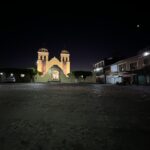
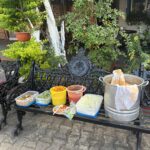
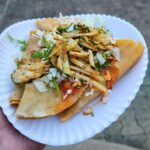
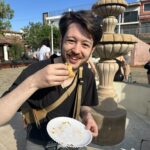
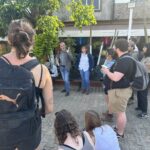
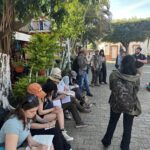
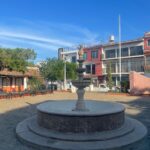
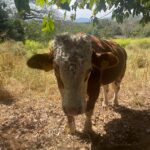
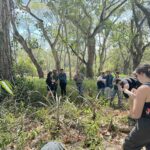
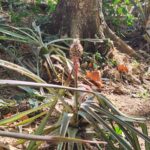
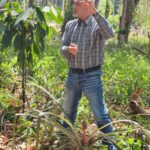
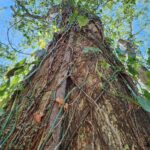






I am really enjoying your blogs, photos and that you are keeping us educated about so much of what you are all experiencing each day! Always looking to see what you are up to in the photos! What a great biology and cultural experience!